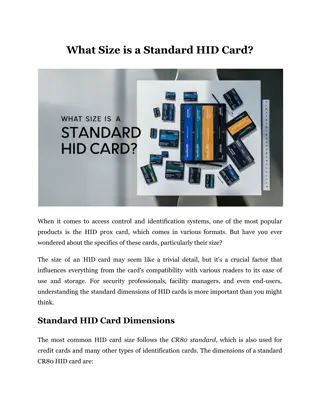
What is an HID proximity card?
Learn what HID proximity cards are, how they work, and their benefits for secure access control in businesses and institutions.n
Download Presentation

Please find below an Image/Link to download the presentation.
The content on the website is provided AS IS for your information and personal use only. It may not be sold, licensed, or shared on other websites without obtaining consent from the author. If you encounter any issues during the download, it is possible that the publisher has removed the file from their server.
You are allowed to download the files provided on this website for personal or commercial use, subject to the condition that they are used lawfully. All files are the property of their respective owners.
The content on the website is provided AS IS for your information and personal use only. It may not be sold, licensed, or shared on other websites without obtaining consent from the author.
E N D
Presentation Transcript
What is an HID Proximity Card? Well, welcome to the fascinating world of HID proximity cards a world where radio waves and microchips dance in silent communication, where security meets convenience, and where the boundaries between physical and digital access blur. A proxy card, often simply referred to as a "prox card," is a contactless smart card used for secure access control and identification purposes. The Fundamentals of HID Proximity Cards At its core, an HID proximity card is a marvel of simple yet effective technology. These cards operate on the principle of Radio Frequency Identification (RFID), allowing for quick, convenient, and secure access to restricted areas. Here's a breakdown of how they function: Embedded Technology: Each card contains a small antenna and a microchip.
Passive Operation: The cards don't require a battery, making them durable and long-lasting. Radio Frequency Communication: When brought within range of a compatible reader, the card is activated by the electromagnetic signal emitted by the reader. Unique Identification: The microchip in the card transmits a unique identification number to the reader. Access Decision: The reader sends this information to a control panel, which decides whether to grant access based on pre-programmed permissions. Unlike magnetic stripe cards or traditional keys, they don't require physical contact with a reader, reducing wear and tear and enhancing user convenience. Read More Articles: Exploring the Best Wineries in Barossa Valley: A Complete Guide Types of HID Proximity Cards A Proximity card supplier offers a range of prox card types, each designed to meet specific needs and environments: Standard Prox Cards: The most common type, suitable for general access control applications. Clamshell Cards: Thicker and more durable, ideal for harsh industrial environments. ISO-Thin Prox Cards: Thinner cards that can be used with photo ID printers for dual-purpose identification and access control. Key Fobs: Compact, key-shaped devices that can be easily attached to a keyring. Adhesive Tags: Small, round tags that can be affixed to non-card objects, expanding the possibilities for access control.
Comparison of HID Proximity Card Types Card Type Thickness Durability Printability Typical Case Use Standard 0.075" Good Yes General environments office Clamshell 0.065" Excellent No Industrial and outdoor settings ISO-Thin 0.030" Moderate Yes Corporate badges ID Key Fob N/A Good No Personal keychain attachment use, Adhesive Tag 0.075" Good No Equipment and asset tracking Features and Benefits of HID Cards The widespread adoption of these proximity cards can be attributed to several key features and benefits: Durability: With no moving parts or battery, these cards are highly resistant to wear and tear, making them ideal for long-term use. Security: Each card has a unique identifier, making unauthorized duplication extremely difficult. This enhances overall system security. Convenience: The contactless nature of prox cards allows for quick and easy use, enhancing user experience and improving traffic flow in high-volume areas. Versatility: An HID prox card can be combined with other technologies like smart chips or magnetic stripes for multi-purpose use.
Customization: Many types of HID cards can be printed with photos, logos, and other identifying information, serving dual purposes as ID badges and access cards. Scalability: Proximity card systems can be easily expanded or upgraded, making them suitable for growing organizations. Security Considerations While HID prox card offers robust security features, it's important to understand their capabilities and limitations: Read Range: Typically limited to a few inches, which can be both a security feature (preventing unauthorized reading from a distance) and a limitation (requiring proximity for use). Encryption: Basic prox cards do not have encryption, though more advanced models and systems do offer encrypted communication. Cloning: While difficult, expert attackers can clone prox cards. This risk can be mitigated through additional security measures. System Integration: The overall security of a prox card system depends not just on the cards themselves, but on the entire access control infrastructure, including readers, control panels, and management software. To enhance security, many organizations combine proximity technology with other security measures like PINs, biometrics, or multi-factor authentication. Read More Articles: What Is The Best Wine Region In Australia? Key Developments in Prox Card Technology The landscape of access control is continuously evolving. Some key developments include: Enhanced Encryption: Newer models of proximity cards offer advanced encryption to prevent unauthorized reading or cloning.
Multi-Technology Cards: Cards that combine proximity technology with other access control technologies, such as smart chips or Bluetooth, for enhanced versatility. Mobile Integration: The development of mobile credentials that can emulate proxy cards on smartphones, offering a new level of convenience and security. Biometric Integration: Systems that combine this technology with biometric verification for multi-factor authentication. Implementing HID Proximity Card Systems For organizations considering implementing or upgrading to an HID card system, several factors should be considered: Existing Infrastructure: Compatibility with current systems and potential for future upgrades. Security Needs: Assessing the level of security required for different areas and choosing appropriate card types and technologies. User Experience: Considering the ease of use and convenience for employees and visitors. Scalability: Planning for future growth and potential expansion of the access control system. Integration: Possibilities for integrating the this card system with other security and management systems. Pick Yours! Boost your security with Bristol ID Technologies your trusted partner in cutting-edge access control solutions! We offer a comprehensive range of HID proximity cards and custom-designed security solutions tailored to your unique needs. Don't compromise on safety choose us for innovative, reliable, and future-proof access control systems that keep you ahead of the curve! Site Article: What is an HID Proximity Card?






















